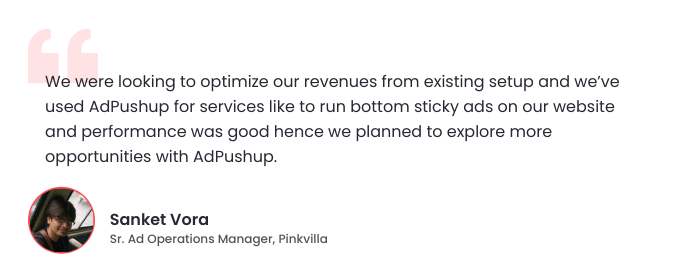In a previous post, we talked to publishers about keeping both eyes peeled while shortlisting technology partners to sell inventory with. That being said, there are two sides to every coin.
No demand source relies entirely on a metric-based benchmark to evaluate publisher’s ad inventory for sale on its platform. Why? Because numbers can be fraudulent. Also, relying entirely on automation could eliminate the possibility of cashing in on changing advertiser demands. It could mean missed business opportunities.
While you are weighing pros and cons of demand platforms, they too are scrutinizing you. Here’s what demand sources usually want from publishers’ ad inventory:
Brand-Safe Content
Marketers object to having their ads placed against objectionable content.
Ever since Times Inc. shined a light on ad tech platforms ‘enabling’ the spread of hate content, every ad tech platform worth its salt is making a concentrated effort to follow brand-safety guidelines.
For reasons of brand-safety, Breitbart lost 90% of its brand advertisers. Ad tech platforms collectively got a sharp rap on the knuckles for turning a blind eye to a pervasive issue. Amazon is still dealing with the fallout with petitions to stop providing services to Breitbart. The dreadful ‘duopoly’ of Google and Facebook had to fast-track a bunch of changes to their ad platforms just to win back advertiser trust.
This meant finally allowing third-party verification within their ‘walled gardens‘. But what classifies as brand-safe for one advertiser may not be so for another.
Consider a major airline. For obvious reasons, an advertiser in this space might not want the brand’s ad to appear next to an article about significant plane delays. Meanwhile, for countless other advertisers, delivering an ad to a consumer in this content would be completely benign.
– via vCE Charter Study
Here’s a list of content categories considered “not brand safe” across the board, in vCE Charter Study:
- Piracy and Copyright Theft
- Criminal Skills / Hacking
- Illegal Drugs / Marijuana
- Spam URLs
- Botnet
- Command Control Centers
- Comprised and Links to Malware / Malware Distribution Point
- Phishing / Fraud / Spyware and Questionable Software
- Torrent Repositories
- Hate Speech
- Pay to Surf
- Adult Content
- Content Server
- Private IP Address
- Redirects
Most brand-name advertisers stay well away from sites under these categories. For this reason, if your site is rejected by an ad network / exchange, make sure to ask the reason why. If your website raised any brand-risk flags, allow the verification vendor that flagged you to monitor ad calls and resolve this issue.
Human Traffic
“Print never had this problem!”
Fraudsters steal from advertisers as well as publishers, while ad tech companies continue to get their cut like everything’s cool.
The ad fraud problem is so rampant that 37% of advertisers say they are willing to pay an 11% premium or more for MRC-certified, human traffic, according to IAB’s Internet Advertising Report. By tackling ad fraud, [ad tech] players have the opportunity to protect their brand clients and reduce the investment wasted on fraudulent traffic.
– Eric Monian, Amobee (via AdExchanger)
Once Methbot revealed the scale of the problem and Marc Pritchard’s blunt ultimatum slapped the industry awake, everyone came together to fight fraud. Today, ‘premium’ inventory is described as ‘brand-safe and viewable (by humans, that is)’.
Sounds terrific! For publishers, however, this means putting up with third-party verification vendors. And therein lies a whole host of complications.
The first of these is a lack of standardized methods for detecting and flagging bot traffic. What one vendor categorizes as ‘fraudulent’ may not raise any flags for another.
Due to the competitive nature of the brand-safety players, there is a “black box” factor as to why one vendor categorizes a site as fraudulent, but another does not. Ad verification partners keep a closed lid on their methodologies used to identify traffic as nonhuman, as they would naturally lose competitive advantage by sharing information.
– via AdExchanger
Now, MRC (Media Ratings Council) guidelines require verification vendors to separate traffic into General (data center traffic, bots and spiders, aka GIVT) and Sophisticated (intentionally misrepresented traffic, aka SIVT) to standardize blacklisting.
Eventually, getting on one vendor’s blacklist may put you on others’ too, essentially marking you as “bad for business” for multiple demand sources.
Publishers need to remember that at the behest of their advertisers, most demand sources will use an MRC-accredited third-party verification vendor like Neilsen, Moat, comScore, etc. to screen websites before on-boarding them. If you’ve been rejected before by an ad network or exchange due to reasons of IVT, ask about the verification vendor that marked your site and reach out to them to resolve the issue.

Valuable Audience Segments
A metric for scale, like x MM Pageviews /month, usually bars the entry to all demand platforms.
But here’s the catch: many demand partners will overlook those numbers if your audience segments are worth it to them.
Thresholds like unique visitors per month are too simplistic, because not all uniques have the same value to advertisers. If you are below the threshold but can demonstrate that you have more valuable kinds of UVs, then they may be more likely to want you on board.
– Scott Kevill, GameRanger
Sites that can boast of traffic with high buyer intent, for instance, are prized commodities — the closer your visitors are to the bottom of a marketing / sales funnel, the more valuable they are to advertisers. Product or price-comparison websites (aka, shopbots) are almost always in demand for precisely this reason.
Audiences with active buyer-intent for automobiles or health or financial services are top shelf segments and could well prompt the demand sources to be more flexible.
Location data works wonders too. An online publisher with an audience of New York residents would be prime audiences for many demand sources. Being a small part of a larger media network almost always helps, for strategic reasons.
Niche matters. There’s always an over-supply of impressions from news and entertainment content. For this reason, niche ad networks will be flexible for quality inventory, but it’s not unheard of for larger ad networks / exchanges to overlook a publication’s scale in favor of relevant audiences in specific verticals, depending on their requirements at a given time.
No respectable demand platform wants to be responsible for flushing ad spend down the toilet. James Hume of Neverstill Media says, “It’s not out of ordinary. I’ve heard tales of publishers getting denied due to reasons of crappy viral content and/or paid traffic.” Such content lacks context and its audience lacks value for advertisers who want conversions.
A demand partner wants publishers that can uphold its reputation and provide value to its advertisers. And that’s subjective. Until every demand partner feels like being more open about their supply-side policies (much like Google with its policy center update), it’d be wise to remember that the approval criteria of an ad network or exchange are not writ in stone and is subject to change.
But now that you know what they want, perhaps you can try and cut yourself a better deal.

Shubham is a digital marketer with rich experience working in the advertisement technology industry. He has vast experience in the programmatic industry, driving business strategy and scaling functions including but not limited to growth and marketing, Operations, process optimization, and Sales.







